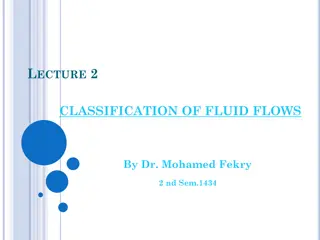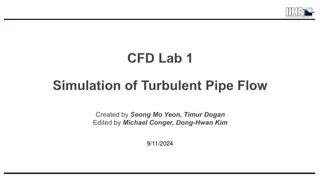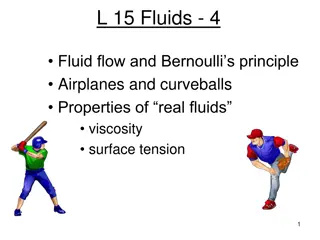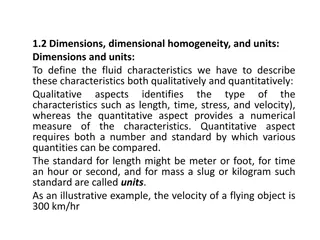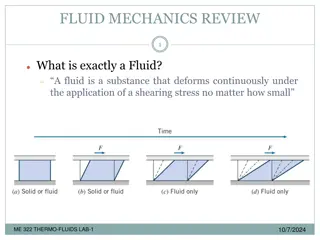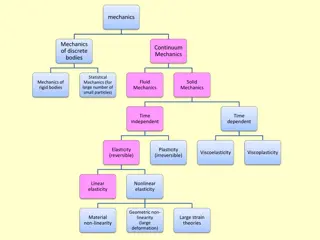Overview of Fluid Mechanics: Branches, Flow Types, and Equations
Fluid mechanics is subdivided into three branches: Fluid Static, Kinematics, and Hydrodynamics. The study of fluid flow includes different types such as uniform, non-uniform, steady, and unsteady flow. The motion of fluid particles obeys Newton's laws, and the conservation of mass and energy plays a crucial role in understanding fluid behavior. Concepts like laminar and turbulent flow, continuity equation, and Bernoulli's equation are fundamental in fluid mechanics.
Download Presentation

Please find below an Image/Link to download the presentation.
The content on the website is provided AS IS for your information and personal use only. It may not be sold, licensed, or shared on other websites without obtaining consent from the author.If you encounter any issues during the download, it is possible that the publisher has removed the file from their server.
You are allowed to download the files provided on this website for personal or commercial use, subject to the condition that they are used lawfully. All files are the property of their respective owners.
The content on the website is provided AS IS for your information and personal use only. It may not be sold, licensed, or shared on other websites without obtaining consent from the author.
E N D
Presentation Transcript
Fluid mechanics may be divided into three branches: 1.Fluid Static is the study of the mechanics of fluids at rest 2.Kinematics deals with velocities and streamlines without considering forces or energy 3.Hydrodynamics is concerned with the relations between velocities and accelerations and forces exerted by or upon fluids in motion. FLUID FLOW The motion of a fluid is usually extremely complex. Uniform flow: If the velocity at a given instant is the same in magnitude and direction at every point in the fluid. If at the given instant the velocity changes from point to point the flow is described as Non-Uniform. Steady flow is one in which the velocity, pressure and cross-section of the stream may vary from point to point but do not change with time. If at a given point conditions do change with time the flow is described as unsteady. There are therefore 4 possible types of flow. (i)Steady Uniform Flow: Conditions do not change with position and time (ii)Steady Non-uniform flow: Conditions change from point to point but not with time (iii) Unsteady Uniform: At a given instant of time the velocity at every point is the same, but this velocity will change with time. (iv)Unsteady-Non-uniform flow: The cross-sectional area and velocity vary from point to point and also change with time. MOTION OF A FLUID PARTICLE Newton s laws : When a force is applied any particle or element of fluid will obey the normal laws of mechanics in the same way as solid body
A body will remain at rest or in a state of uniform motion in straight line until acted upon by an external force. The rate of change of momentum of a body is proportional to the force applied and takes place in the direction of action of that force. Action and reaction are equal and opposite. *Momentum is the product of mass and velocity Force=mass x acceleration F = ma 2000 R LAMINAR AND TURBULENT FLOW Observation shows that two entirely different types of flow exist. This was demonstrated by Osborne Reynolds in 1883. When the flow is Turbulent in pipes. CONTINUITY OF FLOW e Flow is Laminar, but when 2000 a = R a e v v 1 1 2 2 1 Except in nuclear processes, matter is 2 1 mg mv = = = 2 2 v mv 2 2 neither created nor destroyed. This principle of conservation of mass can be applied to a flowing fluid. CONTINUITY EQUATION BERNOULLI S EQUATION states that for steady flow of a frictionless fluid along a streamline, the total energy per unit weight remains constant. P= Pressure V=Velocity mg= Weight Potential energy due to height= zmg Kinetic energy due to velocity 2 g 2 v 2 g Divide through by weight (mg) Potential energy per unit weight=z Kinetic energy per unit weight=
P g Pressure energy per unit weight = H=Constant=Total energy per unit weight 2 P V 2 = + + H z g g (m)=Pressure head plus Velocity head plus Potential head D MOODY S CHART Friction factor f Reynolds Number Re Relative Roughness= 2 LV = ' hf f 2 d g ( Laminar flow ) = ' Re f Laminar Zone Transition zone Complete Turbulent zone Darcy Weisbach Equation for head loss due to friction 64 '= f Re 64 '= f Re FRICTION FACTOR Referring to Moody s Chart for friction factor for pipe, the chart shows that there are four zones. 1.Laminar flow where n 1.A critical range where the values are uncertain because the flow might be either laminar or turbulent 2.Transition zone, where f is a function of both Reynolds number and Relative pipe roughness
. 0 316 '= 1.A zone of complete turbulence where the value of f is independent of Reynolds Number and depends SOLELY upon Relative Roughness There is no sharp line of demarcation between the transition zone and the zone of complete turbulence. For smooth pipes Blasius suggests for Re between 3,000 and 10,000 For values of Re up to 3.000,000 von Karman s equation modified by Prandtl is f / 1 4 Re ( ) 1 = 2 log Re ' 8 . 0 f ' f For all pipes the Hydraulic Institute and many engineers consider the Colebrook equation reliable when evaluating f 1 / . 2 51 D = + 2 log 7 . 3 ' Re ' f f It can be observed from Colebrook equation that : (a)For smooth pipes where the value of is very small, the first term in the bracket can be neglected. (a)If Re is very large the second term in the bracket can be neglected, in such cases the effect of viscosity is negligible and f depends upon D . 0 relative roughness of the pipe. Colebrook equation can also be written as MINOR LOSSES Those losses which occur in pipelines due to bends, elbows, joints, valves, inlet, outlet, expansion, contraction etc are called minor losses. This is a misnomer because in many cases/situations they are more important than the losses due to pipe friction. In general when 1 / . 2 51 D = + 86 ln 7 . 3 ' Re ' f f L D >2000, velocity head and minor losses should be neglected in the Bernoulli s equation.





















